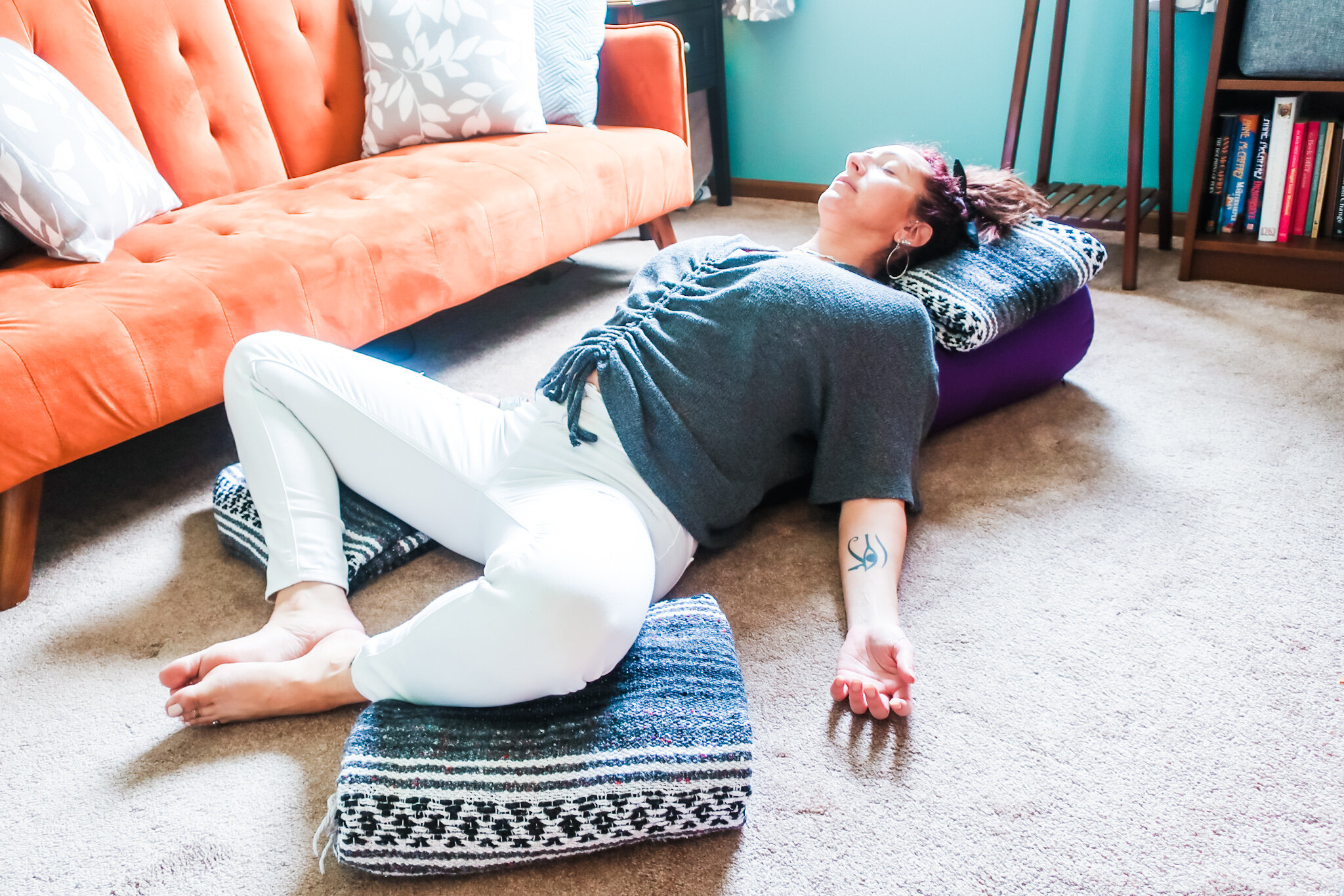You’ve probably heard how calming yoga is. Someone in your life, maybe even you, has said how good she feels after yoga. How relaxed, ready to meet the world, grounded, and centered she feels.
Did you know there’s science behind that? Breathwork and yoga postures (asanas) can calm the sympathetic nervous system, a branch of the autonomic nervous system that becomes active during times of stress. To understand more about the nervous system and stress I highly recommend reading the work of Bessel van der Kolk, especially The Body Keeps the Score.
I do want to note that yoga is not a substitute for medical care. Therapy, coaching and sometimes psychotropic medication may be needed to address anxiety.
If you prefer not to utilize psychiatric services or psychotropic medication that can be totally fine. What that means, though, is you will need to commit to your mental and physical well-being with a gusto you may not have achieved previously.
Nutrition, exercise, breathwork and meditation are some of the vitally important work you need to be willing to do daily to positively impact your anxiety. Lucky for all of us, yoga was built for this!
Stress Response
When you are stressed or anxious you may experience symptoms like the following:
Your heart beats faster
Your breath becomes shallow
You begin to perspire
You become nauseous
Your limbs become weak
These symptoms are due to your body’s response to stress which is to decrease the flow of blood to your internal organs and extremities, and inhibition of your immune and digestive systems.
Relaxation Response
The practice of yoga can initiate the Relaxation Response in your brain, just as a sense of danger can initiate the Stress Response.
The Relaxation Response includes:
The slowing of your heart rate and stabilization of your blood pressure
Boosting of your immune system
Normalizing your digestive processes
Slowing of your brain waves
Improvement in sleep
An overall sense of well-being
8 Limbs of Yoga
To work on your Relaxation Response via yoga we will focus on Posture (aka Asana in Sanskrit), and Breath Control (Pranayama). These are the 3rd and 4th of the 8 Limbs of Yoga found in the Yoga Sutras written by Patanjali somewhere in the vicinity of 400BC. This text contains the philosophy that is yoga.
The 8 Limbs are:
Yama (Restraints)
Niyama (Observances)
Asana (Postures)
Pranayama (Breath Control)
Pratyahara (Sense Withdrawal)
Dharana (Mental Focus)
Dhyana (Meditation)
Samadhi (Enlightenment)
Keep an eye out for future blogs on other Limbs and how they apply to your life path.
Yoga Postures (Asanas) for Anxiety
The practice of yoga asanas is widely recognized as “moving meditation”. In a class you are lead through a sequence of postures. Here I’ll share a few postures you can safely practice on your own when feeling stressed.
Inversions are postures that place the heart lower than the hips, reducing the work the heart has to do to make your blood flow, calming the nervous system. Poses like forward folds are excellent for anxiety because they are inversions.
Please be careful in an inverted position if you have low blood pressure, as this will lower it even further. When I was struggling with fluctuating blood pressure, I could not bend forward any further than midway without becoming light-headed. Listen to your body.
Standing Forward Fold (Uttanasana) Against a Wall or Seated
Take off your shoes and loosen your belt or any clothing around the waist or neck. Stand with your back to the wall with your feet hip-width apart, about six to twelve inches away from the wall. Rest your bum against the wall. Gently bend your knees and fold forward so your head hangs toward the floor.
Dangle your hands, rest them on the ground, hold your opposite elbows and dangle, hold onto your ankles or legs, or even place your hands on something like a chair in front of you.
Focus on breathing for six to ten slow “yogi breaths” (slow, measured breath).
Feel your spine elongate while you relax your hip and gluteal (bum) muscles.
This can also be done sitting in a chair.
When inverted you can imagine all of the stress falling out of the top of your head onto the floor and away from you.
When you are ready to stand up, do so slowly. If you feel light-headed as you come up allow yourself to sit down or kneel on the round until you normalize.
Restorative Pose for Emotional Fatigue
You will need a bolster and 3 blankets or a couple of sofa pillows and three towels or as many pillows and other supports as you need to feel comfortable.
Put one blanket at the top of your bolster.
Lie lengthwise on your bolster with your head on the blanket and bum on the ground.
Bring the soles of your feet together and let your knees gently fall out to the side.
Stack as many blankets and/or pillows as you need under your knees to feel fully supported.
Rest your hands, palms up, next to your body.
Close your eyes. Rest and relax.
Stay in this posture for three to ten minutes.
Focus on the rhythm of your breath.
You can also repeat a mantra of your choosing in your head.
When you are ready to come out of the pose use your hands to help lift your knees back up to center, gently roll to one side in a fetal position, and stay here for a few breaths before using your hands to gently push yourself to a seated position.
Legs up the Wall
This is the number one posture I recommend to do before bed.
You will need one or two blankets or a pillow.
Place the blankets or pillow about six inches from the wall.
Sit close to the wall with your right side to the wall with your bum next to the blankets.
Roll onto your back with your sacrum or tailbone resting on the blankets.
Lift your legs up and rest them on the wall.
Get comfy. Feel free to adjust the blankets as needed. You might like a pillow or blanket under your head as well.
Relax and enjoy.
Stay here 2-10 minutes. If your legs begin to tingle gently come out of the pose right away as that means too little blood is making it up your legs.
This can be performed on your bed against the wall or headboard. It can be done with your knees bent and calves resting on a chair or couch.
If you have no wall you can rest your sacrum on your blankets or a yoga block on the first level and lift your feet to the ceiling allowing your legs to balance over your hips (Waterfall).
A couple of additional postures anyone can do any time are child’s pose (Balasana) and Savasana (corpse pose).
Breath Control (Pranayama)
Breath control, aka breathing, is imperative to the calming of the nervous system. Think about it, if you’re breathing quickly and shallowly while in any of the above postures how relaxed will you feel? Not at all.
Generally speaking, all you need to do in these postures in gentle, slow, conscious breathing. It does not have to be fancy.
Breath Retention
This is breathwork that adjusts your natural breath rhythm to provide additional centering for your mind.
Breathe in as you slowly count to four.
Retain (hold) your breath at the top of the inhalation to the count of four.
Exhale to a count of four.
Repeat this rhythm for a few rounds until you feel comfortable trying a count of five.
Increase or decrease the count as is comfortable for you.
If the breath retention causing an increase in anxiety, return to natural breath for a few moments and then, simply breathe in and out to an equal count of your choosing.
Play with this to find what works best for you. You might even like to vary the breath count. Personally, I like a count of six in, hold for six, breathe out for ten. I always feel like I need to get more air out of my lungs.
Control Over Anxiety
There are many skills out there to help you control your anxiety. These are a great place to start.
I provide guided meditation and relaxation recommendations for all of my coaching clients as needed. I look forward to guiding you on your own journey to control your anxiety through breath and body work.







